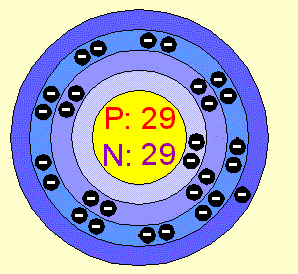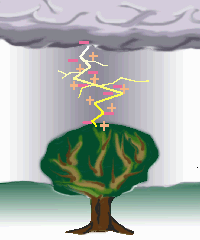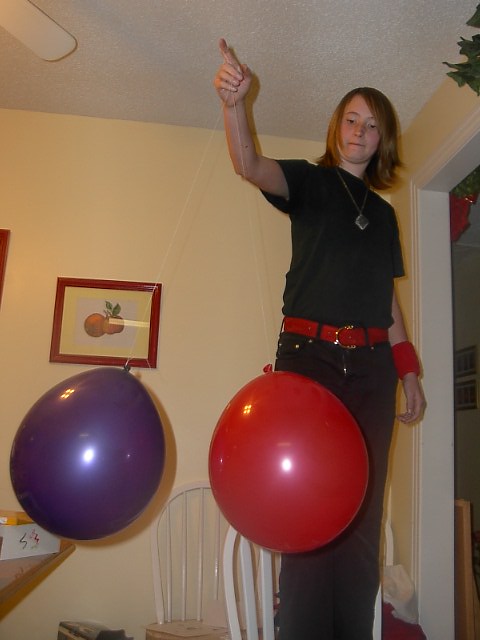Static Electricity
Atoms, in their natural state, have
the same number of protons and electrons. Since electrons and protons have
exactly the same amount of charge but of opposite polarity, the charges balance
each other out and the atom will have no overall (net) charge.
For example, let's say that Joe gets
$5 each week for allowance. That's +5. But if Joe owes Sam $5,
that's -5. How much money does Joe have?
Joe has no money! Because +5-5
= 0
Joe has a net worth of
$0.
Now let's talk a little
electricity! (Charge)
Copper Atom

Now, consider this drawing of a
copper atom. You will notice that it has 29 Positive Protons in the nucleus,
and 29 Negative Electrons in orbit around the nucleus. This atom also has
29 Neutrons in the nucleus, but since they have no charge at all they are not
important in this discussion. Over all, this copper atom has a neutral
charge because the electrons and protons are the same in number and the plus
charge of the protons is canceled out by the negative charge of the
electron.
Protons have positive
charge +29
Electrons have negative charge -29
All
Total............................ 0
Any atom that
has equal numbers of protons and electrons is called a neutral atom because
it's over all charge is neutral. Meaning it has no over all or
"net" charge.
In order to have an over all charge
on an atom, work must be done to add or take away some of it's electrons.
Remember that the protons are deep in the nucleus of an atom and cannot be
removed or added so we have to work with the electrons if we wish to charge an
atom.
If we remove one electron from
the above atom, the atom will be left with a positive over all charge.
Protons have positive
charge +29
Electrons have negative charge -28
only 28 electrons
All
Total............................ +1
If we add one electron to the
atom above, the atom will have a negative over all charge.
Protons have positive
charge +29
Electrons have negative charge -30
All
Total............................ -1
An atom that
has lost or gained an electron is called an Ion. Pronounced
(eye-on).
An atom that has gained an extra
electron is called a negative ion.
An atom that has lost an electron is
called a positive ion.
So, What About Static Electricity
Question:
What is static electricity, and where
does it come from?
Answer:
Static
electricity is defined as charge at rest.
When work is done on atoms to add or take away electrons, the atoms become
imbalanced and take on a charge. Atoms take on a negative charge if they
gain electrons and positive if the atoms loose electrons. If we have
enough of these charged atoms gathered up in one spot---WOW!

Lightning is an example of static electricity in the air. When little
ice crystals whirl around in the clouds, they bump into each other and swap
electrons back and forth. If enough charge is accumulated in the clouds,
look out!
Have you ever walked across the carpet on a winter day and then got a shock
when you touched the doorknob? As you walked across the carpet, your shoes
scrubbed electrons off of the carpet fibers. The electrons built up on
your body. You can accumulate several hundred volts of static electricity
on your body just by walking across the floor. Down south where I live,
the air is so damp most of the time the static charge on my body (electrons)
jumps off into water droplets in the air long before I get to the
doorknob. In the winter, however; the air is dry and the electrons that
get scrubbed off of the carpet jump onto my shoes and then into my socks and
build up on my body. I get all charged up with negative ions. Then
when I get to the doorknob which is made of metal and is a good conductor of
electricity, POW! The electrons hop off of my body onto the
doorknob. If you turn the lights out, sometimes you can see the
spark.
Safety Note: Most people have sense enough to get
out of the rain, so people who are struck by lightning are not out standing in
the rain as you might think. People who are struck by lightning are
usually miles out in front of the rain. If you hear a thunder storm in the
distance, take cover inside. Static electricity builds up in the
atmosphere miles ahead of the storm and this is where most fatalities from
lightning occur. Golfers are the most likely group of people to die from
lightning strike. They are not golfing in the rain. They are trying
to finish the game before the storm arrives.
Do you have any interesting lightning stories to tell, I would love to here
them. Email me!
Experiment Three
Follow the steps below
-
Gather the material in the material
list for Experiment Three.
-
Tear off a piece of notebook paper about the size of a quarter.
-
Touch a comb to the piece of paper. Nothing happens
right.
-
Now take the comb and rub the paper with it.
-
After rubbing the paper with the comb, pick up the comb. What
happened?
Having trouble?
-
If the paper does not stick to the comb, try some different paper.
Some paper has a static coating on it.
-
Still doesn't stick, try a different comb.
-
Try washing your comb to remove any natural oil off of it and try again
when it is completely dry.
What to Notice
-
You should have noticed that before you rubbed the paper and comb
together, they did not stick to each other. Why? Both the comb
and the paper are made of balanced atoms.
-
When work is done (rubbing) the electrons on the paper were scrubbed off
onto the comb. This means that the comb gained electrons and became
negatively charged and the paper lost electrons and became positively
charged.
-
Opposite charges attract each other.
Static Electricity Experiment Part Two
-
Now take two balloons and blow them up. Tie the balloons together
with about four feet of thread.
-
Rub the balloons in your hair. It works best if you rub them both at
the same time. Get someone to rub one of them in their hair while you
rub the other one if necessary. Now hold the balloons by the middle of
the thread.
-
Try not to let the balloons touch anything or they will loose their static
charge.
What to Notice
You should see the two balloons push apart. Why?

This is Maisie my daughter and her balloon experiment.
Both of the balloons will pull (scrub off) electrons out of your hair and become
negatively charged. Since both balloons have the same charge they push
each other away. Like charges repel.
Static Electricity Experiment Part Three
What if you could make cars go using only static electricity. Try
this: Charge up a balloon by rubbing it on your hair or a blanket.
By this time you may need some fresh hair, so borrow your mom or dad. To
keep from discharging the static charge, you may need to hold the balloon with a
sheet of paper (use the paper like a glove). You will need a lot of static
electricity for this part of the experiment.
Now, lay an aluminum can on a flat hard surface and hold the balloon near the
can. Does the can roll toward or away from the balloon? Click
here and tell me why you think the can rolls the way it does.
Discoveries
-
Static electricity is charge at rest. Charge at rest means not
moving like trapped on a balloon, or on a comb, or even on your body.
-
Unlike charges attract.
-
Like charges repel.
This also helps to explain why electrons in a copper wire are pushed away
from the negative terminal of a battery and pulled toward the positive terminal
of a battery. But remember when charge (electrons) are in motion we call
it current. When charge is at rest we call it static electricity.
At this time you are finished with the safety class and ready to review all
the neat things we learned this week. Click "Review" on
the menu.


